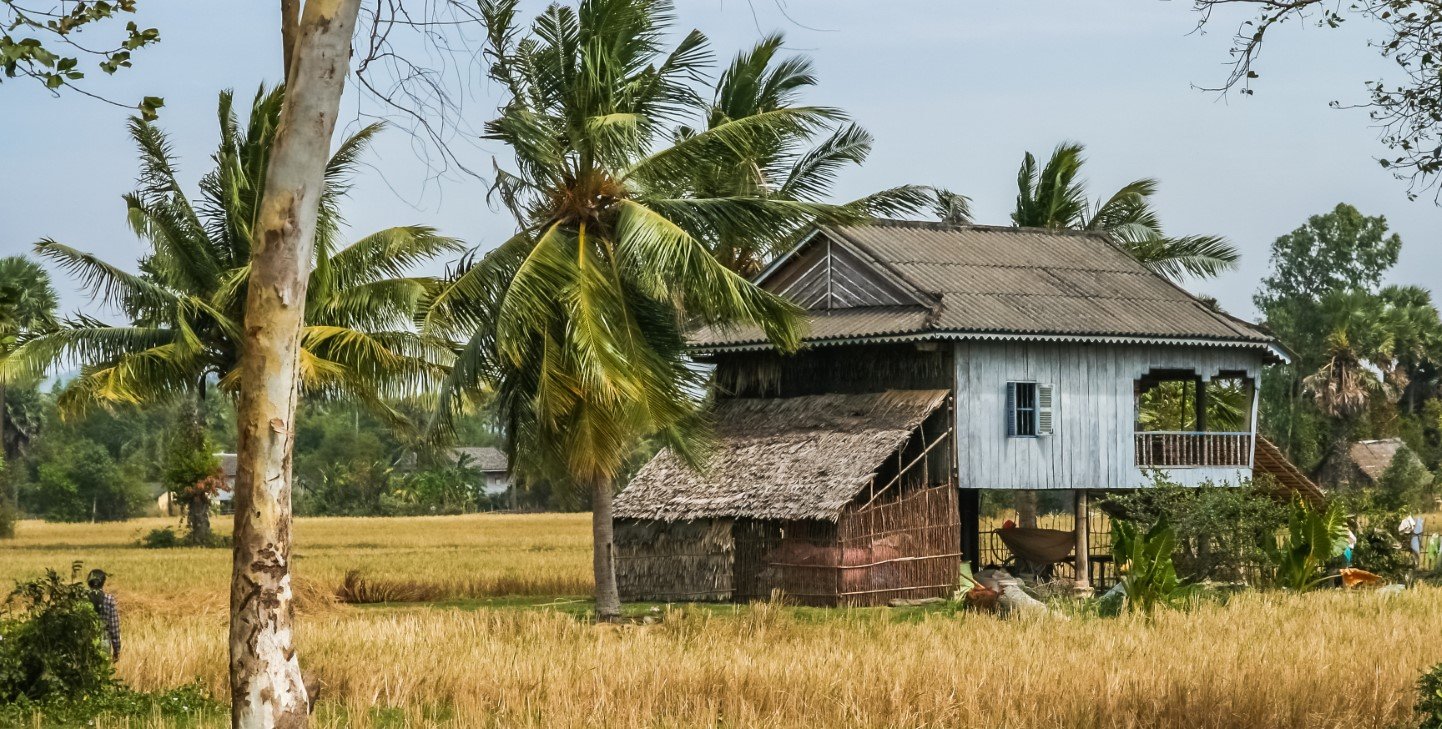A Day in a Cambodian Village: Immersive Rural Travel

A Day in a Cambodian Village: Immersive Rural Travel
Contents
Introduction
Cambodia is famous for its ancient temples and bustling cities, but its true charm often lies in the countryside. Spending a day in a Cambodian village offers a rare glimpse into traditional Khmer life, where time moves slowly, and community bonds are strong. Imagine waking up to roosters crowing, rice fields glistening at sunrise, and warm smiles from locals—this is the magic of rural Cambodia.
Morning in a Cambodian Village
Sunrise and Daily Routines
The Cambodian village awakens at first light, with mist hovering over rice fields as farmers begin their day. Women kindle wood fires to prepare breakfast while children fetch water from communal wells. You’ll hear the rhythmic sounds of mortar and pestle as spices are ground for morning meals. This quiet harmony reveals the enduring traditions of rural life. Visitors can join these rituals, gaining insight into Cambodia’s agricultural roots.
By mid-morning, the village hums with activity as families tend to their daily tasks. Elderly villagers weave fishing nets under stilt houses while monks make their alms rounds. The scent of lemongrass and wood smoke fills the air, creating an atmosphere unchanged for generations. Every activity follows the natural rhythms of the land and seasons. This organic flow of village life offers a stark contrast to urban environments.

Traditional Breakfast
Village breakfasts feature simple but flavorful dishes like num banh chok, rice noodles with fish curry. Fresh ingredients come straight from family gardens and nearby rivers. Meals are often shared on low wooden platforms, with everyone sitting cross-legged. The strong, sweet local coffee provides an energizing start to the day. These morning meals showcase Cambodia’s culinary traditions at their most authentic.
Dining etiquette here values community over formality. It’s common to see multiple generations eating together, passing dishes family-style. Sticky rice is shaped into balls for dipping into shared sauces. Meals become social events where village news is exchanged. Visitors are warmly included in these gatherings, often offered the choicest portions. Such hospitality reflects the Khmer concept of boneay srae (village generosity).

Exploring Village Life
Farming and Local Livelihoods
Rice farming dominates village life, with entire families working in flooded fields. The backbreaking work follows ancient techniques passed down through generations. Water buffalo still pull wooden plows through the thick mud as they have for centuries. Visitors can try transplanting seedlings, quickly learning the skill required. This hands-on experience reveals the hard work behind Cambodia’s staple crop.
Beyond rice, villagers engage in diverse crafts and trades. Some specialize in palm sugar production or bamboo weaving, while others fish using traditional nets. Children learn these skills early, often helping after school. Many households maintain small plots of vegetables and fruit trees. This self-sufficient lifestyle demonstrates remarkable resilience and adaptability.

Cultural Encounters
Village pagodas serve as both spiritual and social centers for the community. The sound of chanting monks mixes with children’s laughter during evening prayers. Visitors should remove shoes and dress modestly when entering these sacred spaces. Local festivals, especially during Khmer New Year, showcase vibrant traditions. These events offer unforgettable glimpses into Cambodia’s living culture.
Schools often welcome visitors interested in rural education. Students proudly demonstrate their English skills to foreign guests. Simple exchanges like playing traditional games build genuine connections. These interactions reveal the warmth and curiosity of Cambodian villagers. Such moments often become the most memorable parts of any visit.

Afternoon Adventures
Nature and Scenic Spots
The countryside surrounding Cambodian villages offers breathtaking vistas. Rice paddies transform into shimmering mirrors during the wet season. Narrow dirt paths wind through coconut groves and past lotus ponds. Early mornings provide the best light for photography and wildlife spotting. These landscapes showcase Cambodia’s natural beauty at its most pristine.
Walking trails often lead to hidden gems like secluded waterfalls or ancient trees. Local guides can point out medicinal plants and edible wild greens. The rhythm of footsteps on earthen paths creates a meditative experience. Such explorations reveal the deep connection between villagers and their environment.

Learning Traditional Crafts
Many villages specialize in particular crafts like silk weaving or pottery. Artisans patiently demonstrate their techniques to interested visitors. The intricate process of creating ikat patterns can take weeks to complete. Trying these crafts firsthand builds appreciation for their complexity. These workshops support the preservation of endangered traditions.
Palm sugar production offers another fascinating glimpse into village industry. Farmers climb tall sugar palms to collect the sweet sap at dawn. The liquid is then boiled in large cauldrons over wood fires. Visitors can taste the fresh syrup, noting its caramel-like flavor. Such experiences connect travelers to Cambodia’s agricultural heritage.

Evening in the Cambodian Village
Sunset Over the Countryside
As daylight fades, the village takes on a golden glow. Farmers lead their oxen home along dusty paths, their silhouettes stretching long. The cooling air carries the scent of evening meals being prepared. This magical hour is perfect for quiet reflection. Few moments capture rural Cambodia’s essence so purely.
The setting sun paints the rice fields in vibrant oranges and purples. Villagers gather to relax after the day’s labors, sharing stories and laughter. Fireflies begin to appear near water sources as twilight deepens. This daily transition from work to rest follows nature’s timeless rhythm. Witnessing it feels like observing a living painting.

Homestay Experience
Overnight stays immerse visitors in authentic village life. Families prepare sleeping areas with clean mats and mosquito nets. Evening meals become cultural exchanges, with hosts explaining each dish’s significance. The lack of electricity enhances the stars’ visibility overhead. Such nights create profound connections between guests and hosts.
Morning brings the opportunity to help with household chores. Fetching water or feeding animals offers hands-on learning. The simplicity of village life becomes its greatest lesson. Visitors often leave with new perspectives on community and contentment. These experiences remain etched in memory long after departure.
Practical Tips for Your Visit
The ideal time to explore a Cambodian village is during the dry season, from November to April, when the weather is cooler and roads are more accessible. The rainy season (May–October) can make rural paths muddy and difficult to navigate, though the lush green landscapes are breathtaking. If you visit in April, you might witness the Khmer New Year celebrations, where villagers engage in traditional games and water festivals. Early mornings and late afternoons are the best times to avoid the midday heat while enjoying the village’s peaceful atmosphere.

Reaching a Cambodian village usually requires a short trip from nearby towns like Siem Reap or Battambang. Tuk-tuks are a popular and affordable choice, but for a more immersive experience, consider renting a bicycle or motorbike. Some eco-tourism organizations offer guided tours, which include transportation and a local guide who can explain village customs. If you’re staying overnight, arrange your return trip in advance, as transportation options may be limited in remote areas.

Finally, Cambodian villagers are warm and welcoming, but observing local customs ensures a respectful visit. Always remove your shoes before entering someone’s home or a pagoda, and avoid pointing your feet at people or sacred objects. It’s polite to ask for permission before taking photos of villagers, especially monks and children. Learning basic Khmer phrases, such as “Sous-dey” (Hello) and “Orkun” (Thank you), will make interactions more meaningful. If invited to share a meal, try a bit of everything to show appreciation—even if it’s something unfamiliar.
Conclusion
A day in a Cambodian village is more than just sightseeing—it’s a journey into the heart of Khmer culture. From sunrise farm work to evening storytelling, every moment is a chance to connect with Cambodia’s rural soul. Ready to step off the beaten path? Plan your village adventure today!
Ready to explore the enchanting Cambodia village tour? Contact Aravinda Travel now for an unforgettable experience!
Contact Details:
- Website: aravindatravel.com
- Facebook: Aravinda Travel – Loyal DMC in South East Asia
- Email: info@aravindatravel.com
- 24/7 Hotline: +84 989 383 572




